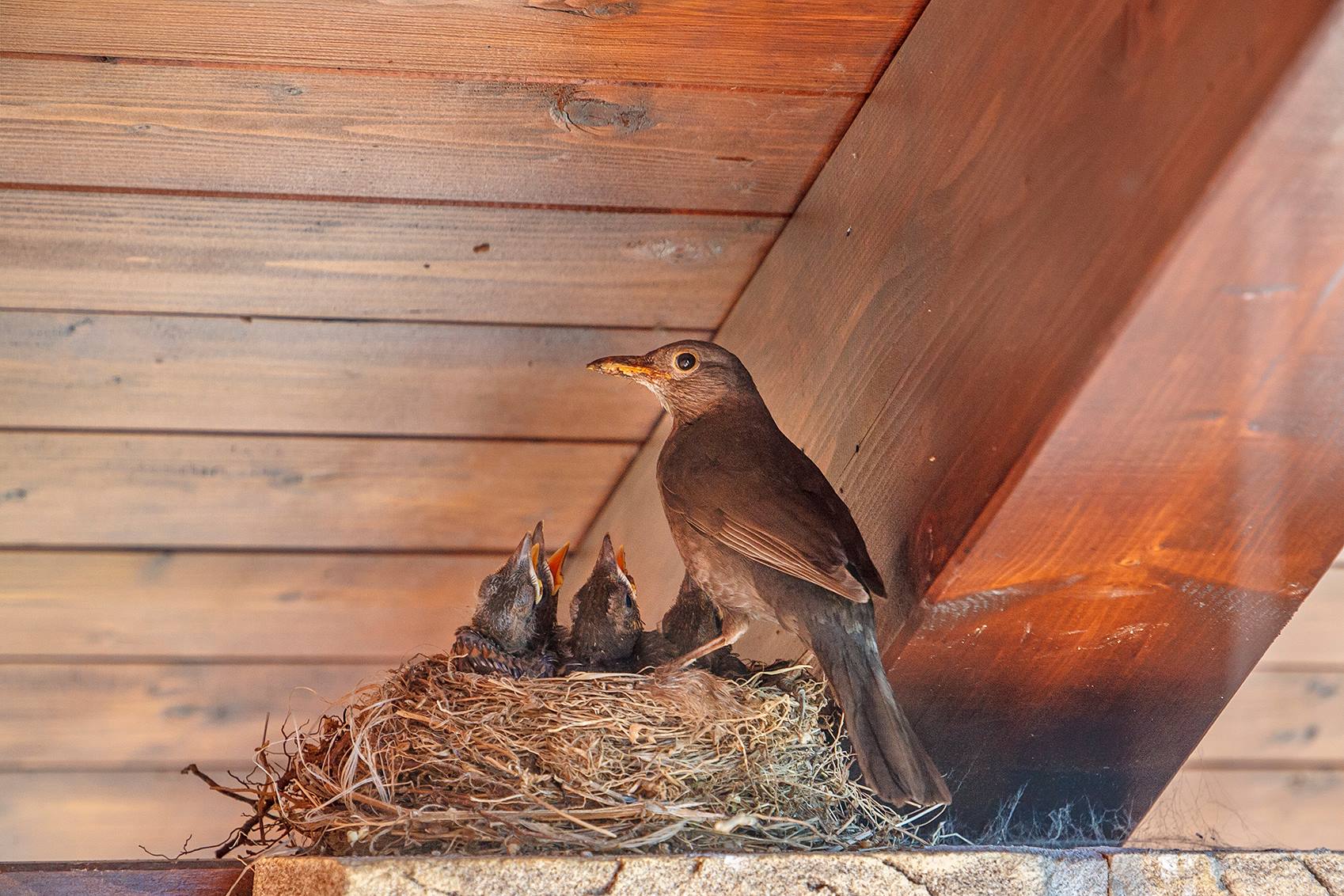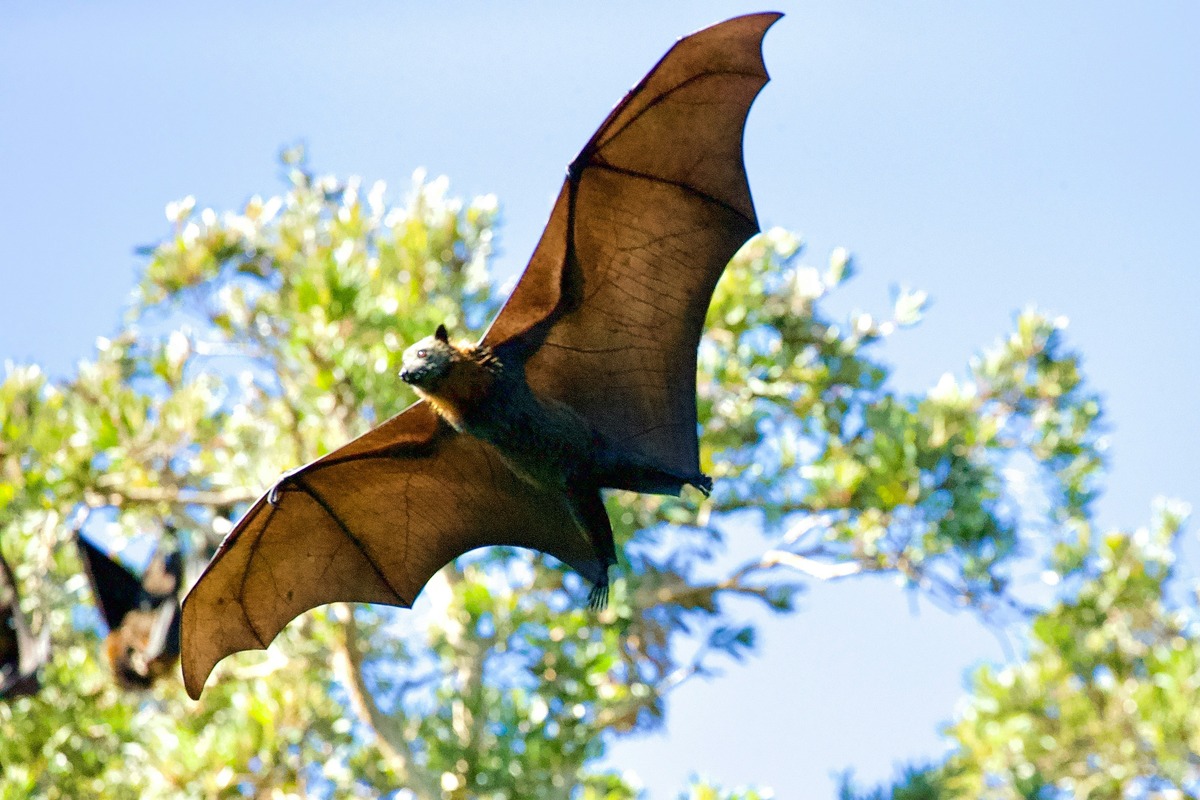Home>Home and Garden>10 Foolproof Ways To Banish Bats From Your Home


Home and Garden
10 Foolproof Ways To Banish Bats From Your Home
Published: February 20, 2024
Discover 10 effective methods to safely remove bats from your home with our expert tips. Protect your home and garden from unwanted visitors today!
(Many of the links in this article redirect to a specific reviewed product. Your purchase of these products through affiliate links helps to generate commission for Noodls.com, at no extra cost. Learn more)
Table of Contents
Introduction
Bats are fascinating creatures that play a crucial role in our ecosystem by consuming insects and aiding in pollination. However, when they decide to take up residence in our homes, they can become a nuisance and pose potential health risks. If you've noticed signs of a bat infestation in your home, such as droppings, strange noises, or sightings of bats themselves, it's crucial to address the issue promptly and effectively.
In this comprehensive guide, we'll explore ten foolproof methods to banish bats from your home and prevent them from returning. From understanding the behavior of bats to employing professional help, we'll cover a range of strategies to suit different situations and preferences. By following these methods, you can reclaim your home from unwanted bat guests and create a safe, bat-free environment for you and your family.
Let's delve into the world of bat removal and discover the most effective techniques for ensuring that your home remains a bat-free zone.
Understanding the Behavior of Bats
Bats are nocturnal creatures, meaning they are most active during the night. They are also highly social animals, often roosting in colonies and seeking shelter in dark, secluded areas during the day. When it comes to choosing a roosting site, bats look for places that provide protection from predators and the elements. This preference for sheltered spaces often leads them to seek refuge in attics, wall voids, chimneys, and other secluded areas within homes.
Understanding the behavior of bats is crucial for effective bat removal and prevention. By gaining insight into their habits and preferences, homeowners can implement targeted strategies to discourage bats from inhabiting their properties. Additionally, recognizing the signs of a bat infestation, such as the presence of guano (bat droppings) or squeaking noises at dusk, can help homeowners take proactive measures to address the issue promptly.
Furthermore, it's essential to acknowledge the ecological significance of bats and their protected status in many regions. While bats may inadvertently find their way into homes in search of shelter, it's important to handle their removal with care and respect for these beneficial creatures. By understanding the behavior of bats and their ecological role, homeowners can approach bat removal in a responsible and informed manner.
In summary, understanding the behavior of bats involves recognizing their nocturnal nature, social tendencies, and preferences for roosting sites. By familiarizing oneself with these aspects of bat behavior, homeowners can develop effective strategies for bat removal and prevention, ultimately creating a harmonious living environment for both humans and bats.
Identifying Entry Points
Identifying entry points is a crucial first step in addressing a bat infestation. Bats can enter homes through surprisingly small openings, often exploiting gaps and cracks that may go unnoticed by homeowners. Common entry points for bats include damaged roof tiles, uncapped chimneys, gaps in siding, and openings around utility penetrations. To effectively banish bats from your home, it's essential to conduct a thorough inspection to identify these entry points and take the necessary steps to seal them off.
Start by visually inspecting the exterior of your home, paying close attention to areas where different building materials meet, as well as any potential gaps or crevices. Look for signs of bat activity, such as guano or dark stains near entry points, which can indicate frequent bat traffic. Additionally, consider conducting an evening observation to spot bats as they emerge from their roosting sites, helping pinpoint the specific entry points they are using.
Once potential entry points have been identified, it's important to prioritize their closure to prevent further bat intrusion. Seal any openings with materials such as caulk, weatherstripping, or hardware cloth, ensuring a snug and durable barrier that bats cannot penetrate. Keep in mind that bats can access openings as small as a quarter of an inch, so meticulous attention to detail is crucial when sealing entry points.
In some cases, entry points may be located in challenging or hard-to-reach areas, such as high on the roof or within attic spaces. In these instances, enlisting the help of a professional pest control or wildlife removal service can ensure thorough and effective closure of entry points, minimizing the risk of future bat incursions.
By diligently identifying and sealing entry points, homeowners can significantly reduce the likelihood of bats re-entering their homes, creating a secure and bat-free living environment. This proactive approach not only addresses the immediate infestation but also serves as a long-term preventive measure, safeguarding homes against potential bat intrusions in the future.
Sealing Entry Points
Sealing entry points is a critical step in the process of bat removal and prevention. Bats are remarkably adept at squeezing through small openings, making it essential to meticulously identify and seal off any potential entry points to effectively banish them from your home.
The first step in sealing entry points involves conducting a comprehensive inspection of the exterior of your home. Carefully examine areas where different building materials meet, as well as any gaps, cracks, or crevices that could serve as potential entry points for bats. Keep an eye out for signs of bat activity, such as guano or dark stains near entry points, which can indicate frequent bat traffic. Additionally, consider conducting an evening observation to spot bats as they emerge from their roosting sites, helping pinpoint the specific entry points they are using.
Once potential entry points have been identified, it's crucial to prioritize their closure to prevent further bat intrusion. Seal any openings with durable materials such as caulk, weatherstripping, or hardware cloth, ensuring a snug and impenetrable barrier that bats cannot breach. It's important to note that bats can access openings as small as a quarter of an inch, emphasizing the need for meticulous attention to detail when sealing entry points.
In some cases, entry points may be located in challenging or hard-to-reach areas, such as high on the roof or within attic spaces. When faced with such situations, enlisting the help of a professional pest control or wildlife removal service can ensure thorough and effective closure of entry points, minimizing the risk of future bat incursions.
Furthermore, it's essential to address potential entry points without compromising the ventilation and airflow requirements of your home. Utilizing exclusion devices, such as one-way valves, can allow bats to exit their roosting sites but prevent them from re-entering, facilitating a humane and effective approach to sealing entry points.
By diligently identifying and sealing entry points, homeowners can significantly reduce the likelihood of bats re-entering their homes, creating a secure and bat-free living environment. This proactive approach not only addresses the immediate infestation but also serves as a long-term preventive measure, safeguarding homes against potential bat intrusions in the future.
In summary, sealing entry points is a fundamental aspect of bat removal and prevention, requiring thorough inspection, meticulous sealing techniques, and, when necessary, professional assistance to ensure the effective exclusion of bats from your home.
Using Repellents
When dealing with a bat infestation, using repellents can be a valuable strategy to discourage bats from roosting in and around your home. It's important to note that repellents should be used in conjunction with other bat removal methods and should not be relied upon as the sole solution. However, when employed correctly, repellents can complement other techniques and contribute to the overall effectiveness of bat removal efforts.
One commonly used repellent for bats is naphthalene, which is available in the form of mothballs. Naphthalene emits a strong odor that bats find unpleasant, prompting them to seek alternative roosting sites. When using naphthalene-based repellents, it's crucial to follow safety guidelines and use them in well-ventilated areas to minimize human and pet exposure to the fumes.
Another repellent option is the use of strong scents, such as menthol or eucalyptus oil, which can deter bats from lingering in specific areas. These scents can be applied to surfaces near bat roosting sites, creating an environment that bats find undesirable. However, it's important to reapply these scents regularly, as their effectiveness diminishes over time.
Ultrasonic devices are also marketed as bat repellents, emitting high-frequency sound waves that are intended to drive bats away. While some homeowners report success with these devices, their effectiveness remains a topic of debate. Research on the efficacy of ultrasonic bat repellents is ongoing, and it's essential to approach these devices with a degree of caution and skepticism.
It's important to exercise caution when using repellents, as their effectiveness can vary depending on factors such as the specific species of bats present and the environmental conditions. Additionally, repellents should be used in accordance with local regulations and guidelines, as certain products may be subject to restrictions or prohibitions in different regions.
When considering the use of repellents, it's advisable to consult with wildlife experts or pest control professionals to gain insights into the most suitable and effective repellent options for your specific situation. By integrating repellents into a comprehensive bat removal strategy that includes identifying entry points, sealing off access, and implementing preventive measures, homeowners can enhance their efforts to banish bats from their homes effectively.
In summary, while repellents can be a useful component of bat removal efforts, they should be used judiciously and in conjunction with other proven methods to achieve optimal results. By approaching the use of repellents with a well-informed and strategic mindset, homeowners can contribute to creating a bat-free environment while respecting the ecological significance of these remarkable creatures.
Installing Bat Houses
Installing bat houses can serve as an effective and environmentally friendly method for managing bat populations while providing these beneficial creatures with alternative roosting sites. Bat houses, also known as bat boxes, are specially designed structures that offer bats a safe and comfortable habitat, encouraging them to roost in designated areas rather than within homes or other undesirable locations.
When strategically placed, bat houses can attract bats and provide them with a suitable roosting environment, ultimately reducing the likelihood of bats seeking shelter in residential structures. By offering bats an appealing alternative to human dwellings, homeowners can contribute to bat conservation efforts while simultaneously addressing potential bat infestations in their own properties.
To maximize the effectiveness of bat houses, it's essential to consider several key factors when installing these structures. First and foremost, the location of bat houses plays a crucial role in their attractiveness to bats. Ideally, bat houses should be mounted in areas that receive ample sunlight, typically facing south or southeast to ensure optimal warmth and exposure to sunlight, which bats prefer. Additionally, positioning bat houses near water sources, such as ponds or streams, can further enhance their appeal to bats, as these locations provide essential drinking and foraging opportunities.
Furthermore, the height at which bat houses are installed is a critical consideration. Mounting bat houses at least 12 to 15 feet above the ground, away from potential obstructions and predators, can increase their appeal to bats while providing a secure and inviting roosting space. It's important to ensure that bat houses are securely affixed to sturdy structures, such as poles or buildings, to prevent instability and ensure the safety of the roosting bats.
When selecting or constructing bat houses, it's advisable to choose designs that accommodate the roosting preferences of local bat species. Different bat species have varying roosting requirements, including cavity size, temperature preferences, and roosting space configuration. Tailoring bat house designs to align with the needs of local bat populations can enhance their attractiveness and encourage bats to utilize these structures as alternative roosting sites.
In summary, installing bat houses presents a proactive and eco-friendly approach to managing bat populations and mitigating potential bat infestations in residential properties. By strategically siting and designing bat houses to align with the preferences of local bat species, homeowners can contribute to bat conservation efforts while creating a harmonious living environment for both humans and bats.
Using Ultrasonic Devices
Ultrasonic devices are marketed as a potential solution for deterring bats from roosting in residential and commercial spaces. These devices emit high-frequency sound waves that are intended to disrupt the echolocation and communication abilities of bats, creating an environment that is perceived as inhospitable or uncomfortable for these nocturnal creatures.
Proponents of ultrasonic bat repellents advocate for their non-invasive nature, as these devices are designed to operate silently and without emitting odors or chemicals. This aspect of ultrasonic devices may appeal to homeowners seeking a discreet and low-maintenance method for addressing bat infestations. Additionally, ultrasonic devices are often promoted as a humane alternative to traditional pest control methods, as they do not rely on physical traps or harmful substances.
However, the effectiveness of ultrasonic bat repellents remains a subject of debate and ongoing research within the scientific community. While some homeowners report success with these devices in deterring bats, the empirical evidence supporting their efficacy is limited. Factors such as the specific species of bats present, the layout of the affected area, and the environmental conditions can influence the performance of ultrasonic devices, leading to varying outcomes in different scenarios.
Critics of ultrasonic bat repellents highlight the need for cautious consideration when relying on these devices as the primary method for bat removal. The variability in results and the lack of comprehensive scientific validation raise concerns about the reliability of ultrasonic devices in consistently repelling bats from residential structures. Furthermore, the potential for habituation, wherein bats may become accustomed to the presence of ultrasonic waves over time, underscores the need for a multifaceted approach to bat removal that incorporates complementary strategies.
When contemplating the use of ultrasonic devices, homeowners are encouraged to approach these products with a discerning mindset and consider them as part of a comprehensive bat removal strategy rather than a standalone solution. Consulting with wildlife experts or pest control professionals can provide valuable insights into the suitability and potential limitations of ultrasonic devices in specific contexts, helping homeowners make informed decisions regarding their use.
In summary, while ultrasonic devices hold promise as a non-invasive and humane method for addressing bat infestations, their effectiveness remains a topic of ongoing research and debate. By integrating ultrasonic devices into a broader bat removal strategy that encompasses thorough inspection, sealing entry points, and implementing preventive measures, homeowners can optimize their efforts to create a bat-free living environment while respecting the ecological significance of these remarkable creatures.
Employing Bright Lights
Employing bright lights is a strategic and non-invasive method for discouraging bats from roosting in and around residential structures. Bats are nocturnal creatures that are sensitive to light, and by strategically illuminating areas where bats are known to roost, homeowners can create an environment that is less appealing to these winged mammals.
One approach to employing bright lights involves installing motion-activated floodlights or spotlights in areas where bats are observed or suspected to roost. When bats are exposed to sudden and intense illumination, they may become disoriented and seek alternative, darker roosting sites. Additionally, the activation of bright lights can disrupt the nocturnal activities of bats, prompting them to relocate to more suitable environments away from the illuminated areas.
Another effective use of bright lights involves maintaining consistent and well-lit conditions in and around potential bat roosting sites. By ensuring that attics, eaves, and other secluded areas are well-lit during nighttime hours, homeowners can create an environment that is less conducive to bat habitation. This approach can be particularly effective in combination with other bat removal methods, such as identifying and sealing entry points, as it reinforces the message that the affected areas are unsuitable for bat roosting.
It's important to note that the use of bright lights should be balanced with considerations for energy efficiency and the potential impact on human residents. Employing energy-efficient lighting solutions, such as LED fixtures, can minimize the environmental footprint while effectively deterring bats. Additionally, ensuring that bright lights do not cause undue disruption or discomfort to human inhabitants is essential when implementing this method.
When employing bright lights as a bat removal strategy, it's advisable to consider the specific roosting behaviors and preferences of the bat species in question. Different bat species may exhibit varying responses to bright lights, and tailoring the application of this method to align with the habits of local bat populations can enhance its effectiveness.
In summary, employing bright lights presents a practical and environmentally conscious approach to discouraging bats from roosting in residential areas. By strategically utilizing motion-activated or consistent illumination in and around potential bat roosting sites, homeowners can contribute to creating a bat-free living environment while respecting the ecological significance of these remarkable creatures.
Seeking Professional Help
When faced with a persistent or complex bat infestation, seeking professional help from pest control experts or wildlife removal specialists can provide invaluable support in effectively addressing the issue. Professional assistance offers homeowners access to specialized knowledge, experience, and resources, enhancing the likelihood of successful bat removal while ensuring the humane treatment of these beneficial creatures.
Professional wildlife removal services possess the expertise to conduct thorough inspections of residential properties, identifying entry points, roosting sites, and potential areas of bat activity. This comprehensive assessment enables professionals to develop targeted and customized strategies for bat removal, addressing the specific needs and challenges presented by each unique infestation.
Moreover, wildlife removal specialists are equipped with the necessary tools and equipment to safely and effectively seal entry points, preventing bats from re-entering homes and other structures. Their proficiency in utilizing exclusion devices, such as one-way valves, allows for the humane removal of bats while minimizing the risk of future infestations.
In addition to physical removal and exclusion techniques, pest control professionals can provide guidance on the use of repellents, deterrents, and preventive measures tailored to the specific circumstances of the bat infestation. Their insights into the behavior and habits of bats enable them to recommend the most suitable and effective approaches for deterring bats from residential areas.
Furthermore, engaging professional help for bat removal ensures compliance with local regulations, ethical considerations, and safety standards. Wildlife removal experts are well-versed in the legal and ethical aspects of bat management, ensuring that removal efforts align with conservation guidelines and animal welfare principles.
By enlisting the expertise of professional pest control or wildlife removal services, homeowners can gain peace of mind knowing that their bat infestation is being addressed with precision, care, and respect for both human inhabitants and the bats themselves. Professional assistance not only facilitates the effective resolution of bat infestations but also contributes to the preservation of bat populations and the ecological balance within residential environments.
In summary, seeking professional help for bat removal offers homeowners access to specialized knowledge, resources, and ethical practices, enhancing the effectiveness and sustainability of bat management efforts. By collaborating with experienced wildlife removal specialists, homeowners can navigate the complexities of bat infestations with confidence and ensure the creation of a bat-free living environment in a responsible and humane manner.
Conclusion
In conclusion, addressing a bat infestation in your home requires a multifaceted approach that encompasses understanding the behavior of bats, identifying and sealing entry points, utilizing repellents and deterrents, installing bat houses, and seeking professional assistance when necessary. By integrating these strategies, homeowners can effectively banish bats from their living spaces while respecting the ecological significance of these remarkable creatures.
Understanding the behavior of bats is fundamental to implementing targeted and effective bat removal methods. By recognizing their nocturnal nature, social tendencies, and preferences for roosting sites, homeowners can develop proactive strategies to discourage bats from inhabiting their properties. This knowledge also fosters a sense of coexistence with bats, acknowledging their ecological role while striving to maintain a harmonious living environment.
Identifying and sealing entry points is a critical step in preventing bat intrusions and creating a secure home environment. Thorough inspections and meticulous sealing techniques minimize the risk of future bat incursions, safeguarding homes against potential infestations. This proactive approach not only addresses immediate concerns but also serves as a long-term preventive measure, contributing to a bat-free living space.
The use of repellents and deterrents, such as bright lights and ultrasonic devices, can complement other bat removal methods, offering additional strategies to discourage bats from roosting in residential areas. When employed judiciously and in conjunction with other proven methods, these approaches contribute to creating a bat-free environment while respecting the ecological significance of these remarkable creatures.
Installing bat houses presents an eco-friendly and proactive method for managing bat populations while providing bats with alternative roosting sites. By strategically siting and designing bat houses to align with the preferences of local bat species, homeowners can contribute to bat conservation efforts while addressing potential bat infestations in their own properties.
Seeking professional help from pest control experts or wildlife removal specialists can provide invaluable support in effectively addressing persistent or complex bat infestations. Professional assistance ensures the humane treatment of bats while facilitating compliance with local regulations, ethical considerations, and safety standards.
In essence, the comprehensive and proactive approach to bat removal and prevention outlined in this guide empowers homeowners to reclaim their living spaces from unwanted bat guests while fostering a sense of coexistence with these valuable creatures. By integrating knowledge, strategic methods, and professional expertise, homeowners can create a bat-free environment that prioritizes both human well-being and the ecological significance of bats.













